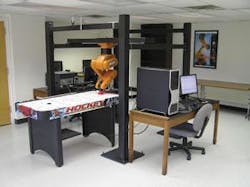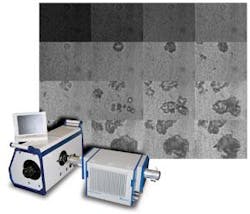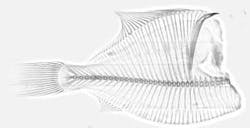Snapshots
From air hockey to bin picking
Using technology that can be applied to dynamic bin picking by vision-guided robots, a development team at Ohio Northern University (Ada, OH, USA; www.onu.edu/a+s/techno/robothockey) is creating a robotic system to compete against a human in the game of air hockey. Dynamic bin picking is similar to static bin picking but the parts being picked are in motion. The dynamics of the parts being picked create a need for the parts to be tracked. In a project led by assistant professor of technological studies Adam Stienecker, the part being tracked is a hockey puck that is moving along the surface of an air hockey table.
In this case the puck will not be tracked and picked but will be tracked and hit back to a person at the other end of the table. The system uses a KR3 six-axis robot from KUKA (Clinton Township, MI, USA; www.kuka.com/usa) and a Flea2 FireWire camera from Point Grey Research (Vancouver, BC, Canada; www.ptgrey.com).
To date, the team has successfully developed the ability to defend the goal from the strike of an opponent given a reasonable velocity. Work on phase two—offensive play—will begin shortly. In phase three, the developers plans to create an artificial intelligence that will learn strategy from other opponents. The team serves industry through proof-of-concept research and development in the areas of robotics and machine vision; a video and more information are available at www.vision-system.com/resources/video.html.
Visualizing nanoscale biomedical events
Recording simultaneous, ultrafast 2-D and time-resolved images is of significant interest to scientists in a growing number of fields. Traditionally such measurements have been accomplished by using two independent imaging systems looking at the event at slightly different angles of view or through external imaging beam-splitting optical configurations that can limit light-collecting efficiency. More recently, cameras with built-in imaging beamsplitters allowed for streak tubes and their electronics to be fitted into the same camera body as the framing electronics but limit the versatility, primarily of the streak functions.
For many years, the department of radiology at the University of Michigan (Ann Arbor, MI, USA; www.umich.edu) has been studying the cycles of contraction and expansion of micro droplets and bubbles in a liquid medium when hit with an acoustic shock wave. To improve the versatility of the imaging system, researchers recently used a dual-camera system made up of an SIM8-02 ultrafast framing camera from Specialised Imaging (Tring, UK; www.specialised-imaging.com) and an Optoscope SC-10 streak camera from Optronis (Kehl, Germany; www.optronis.com). Framing data images show very detailed 2-D information of the full field of view. By comparison the recorded streak images give a continuous record of time looking at a slit image of the diameter of droplets. Both cameras together give insight into the visualization of biomedical micro- and nanoscale events.
Traffic monitoring with lasers and vision
Twelve fixed PoliScan speed systems designed by Vitronic (Wiesbaden, Germany; www.vitronic.com) will begin operation on state trunk and regional roads in Lithuania this summer. Light detection and ranging (lidar) and digital imaging technology provide speed enforcement on up to three lanes of traffic. The target of the Lithuanian authorities is to reduce the number of deaths caused as a result of unsafe speeds by 25% before 2010.
In contrast to many older technologies, the lidar–based system enables multiple vehicles to be identified and tracked on up to three lanes from a single system. With lane-specific speed detection, not even drivers traveling parallel or tailgating can avoid enforcement. If a driver is caught speeding, a color photograph of the vehicle is sent, along with additional case data, via a wireless connection to the Lithuanian traffic police for further processing. The case file is encrypted to prevent data manipulation. The system architecture also provides the possibility of classifying vehicles.
X-rays detect food contaminants
Small foreign bodies and packaging defects are frequently not detected by food producers, but a new x-ray inspection technology has been developed by a research consortium. Already in commercial use, the technology was developed by the EU’s Modulinspex (Modular High Speed X-ray Detection and Sorting Systems for Production Process Control and Packaging Quality Control) project. It uses low-energy x-rays to produce highly detailed images of food products and packaged goods. The images are then scanned via inspection software that can automatically detect any irregularities accurately and quickly.
The system can be used to check seals on food wrappers, locate packaging defects, and find foreign particles of any size in any kind of food. “Even in an era of high food standards and sterilized packaged produce, problematic foreign bodies and packaging flaws are more common than most people realize,” says Jørgen Rheinlænder, the managing director of InnospeXion (Hvalsoe, Denmark; www.innospexion.dk), which helped develop the technology.




